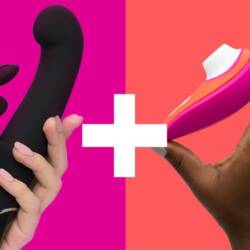Old Enough to Know Better: Seniors and Sex Tech
Sexual pleasure should and must be ageless

According to the United States Census, in 2020, twenty-three percent of the current US population was at least sixty-five years old, if not older. The same year, The World Health Organization (WHO) estimated that by 2030, one out of six people on the planet will be around the same age.
Despite all this, the sex tech industry often seems intent on ignoring those of us with a little snow on our roofs, not to mention the WHO‘s estimated world’s 1.3 billion disabled persons.
Fortunately, some companies have begun to understand that sexual satisfaction doesn’t have an age limit, embracing an innovative new approach to designing and manufacturing sex tech products that everyone, regardless of age or mobility concerns, can enjoy.
Starting with what every industry, sexual or otherwise, should do to meet the needs of their customers—however old or young they might be.
Hearing what we have to say
Writing for TechXplore, Stephanie Hatzifilalithis, Ph.D. in Social Gerontology and Postdoctoral Fellow at the McMaster Institute for Research on Aging, posed three age-related questions for the sex tech industry.
She began by addressing its lack of universal design. Spearheaded by the architect, educator, and product designer Ronald Mace, universal design advocates everything should be usable by everyone, as in durable and simple to understand and control.
Dr. Hatzifilalithis next asked if sexual technology is intrinsically age-biased and if it also helps propagate ageism.
Lastly, and what I think is the most crucial question: “Why aren’t we listening to older people when designing tech for their use?”
Building better, more universal sextoys
Two short years shy of when the US government considers a person “senior,” I’d like to offer my own age-icated (ouch) thoughts on sex tech’s footdragging regarding senior inclusivity—and how the industry might address them.
Control is a biggie. From nearly invisible built-in buttons to confusing, glitchy, or merely badly-designed smartphone apps, it too often seems that the current crop of teledildonic devices are more like puzzles to be solved than products to be enjoyed.
That said, kudos to Lovense for bucking this unfortunate trend, compliments of their far more intuitive built-in controls and the work they put into making their Android and iOS smartphone app remarkably easy to set up and use.
Though their tech could still do with some senior-supportive improvements, like voice activation, a simplified app interface, or contrasting-colored or uniquely textured buttons.
As someone equipped with a penis, I’d like to see less emphasis on getting and staying hard: especially as erections aren’t and never have been the sole measure of sexual or emotional satisfaction.
Looking forward, why not a range of devices for people who like to give sexual pleasure rather than receive it: where are our cunnilingus or specifically fellate-able toys or ones specifically made to caress, savor, nibble, or spank?
We deserve a new world of adaptable, elegant, upgradable, recyclable, modular, and intuitive devices so everyone, regardless their age, can have fun.
Co-design equals co-supportive
Before we can get there, the sex tech industry’s got to listen. As Hatzifilalithis writes, “Researchers, designers, and technology developers need to take the initiative and spend time to think through personal biased related to age-based stereotypes to design tech with older people.”
Come on, all you developers, designers, and innovators: hear us when we say sex doesn’t and never has had an expiration date.
Image Sources: JoslynLM, auimeesri, Joe Shlabotnik



















